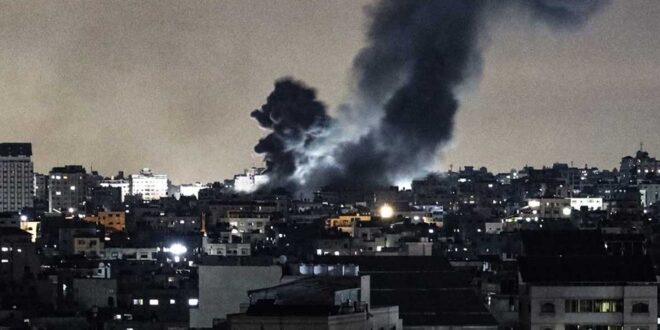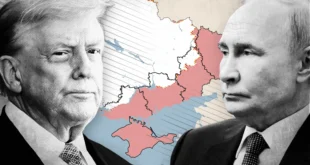Mariam Nadeem
Since the October 7 Hamas attack, Israel has unleashed a level of devastation on Gaza that goes far beyond any claim of targeted retaliation. Entire neighborhoods have been flattened, hospitals reduced to rubble, schools turned to graves, and refugee camps bombed with no regard for the human lives within them. What has unfolded is not simply a war, but a systematic dismantling of a people’s ability to exist; with food, water, medicine, and even the sky denied to them under pretense of self-defense. As this genocide unfolded live before the eyes of the world, Western states, the self-proclaimed guardians of human rights and international law chose silence, justification, or worse, active complicity. In their support for Israel, they revealed a grim hypocrisy: that some lives are mourned, while others are measured as collateral damage. In doing so, they exposed a painful truth that justice is not blind, it is selective, and law crumbles when power chooses to look the other way. This conflict marked only the beginning of a broader erosion of legal norms that would fully unfold in 2025.
Power, Pretext and Pre-emption; Rewriting the Rules of Engagement in South Asia
After the Pahalgam attack in Occupied Kashmir which claimed 26 civilian lives, Pakistan was hastily accused of terrorism by India, without any concrete evidence and independent investigation, with country’s top leadership vowing to take a decisive military action against terrorist infrastructure across the border. On the night of 6–7 May, India launched Operation Sindoor and struck religious sites within Pakistan terming them terrorist sanctuaries, killing innocent civilians including children. This assault based on pretext of self-defense, lifted straight from the Israeli playbook, was carried out in a global climate already shaped by Israeli actions in Gaza where militarily powerful states begin justifying aggression against smaller nations without proof, without adherence to international law, and in blatant violation of national sovereignty.
India leaned heavily on the overused rhetoric of terrorism, forgetting that it was not a global trendsetter in geopolitical narratives, and that the era of rallying international support under blanket justification for “fight against terrorism” had long since passed. It launched Harop & Heron drones (ironically, imported from Israel) and a barrage of SCALP, HAMMER & BrahMos missiles deep into Pakistani territory, in an attempt to test the limits of Pakistan’s tolerance for territorial incursions. This, despite the fact that Pakistan had not responded with retaliatory strikes after the events of 6–7 May, choosing instead to assert its defensive capability by downing six Indian fighter jets and successfully thwarting multiple missile attacks, thereby demonstrating the superiority of its armed forces.
India’s Operation Sindoor marked a dangerous turning point in the history of South Asia, one that has irreversibly altered the rules of engagement between two nuclear-armed neighbors. What was once a fragile line between provocation and restraint has now been replaced by a new, more aggressive playbook: missiles and drones cross borders without declaration, and religious sites or civilian spaces are no longer off-limits. This shift has brought the threshold of war dangerously low. The operation wasn’t about punishing an alleged act of terrorism but about testing how far one state could go before the other responded in kind. While Pakistan showed remarkable restraint by choosing not to escalate, it was forced to launch Operation Bunyan-um-Marsus in response to India’s consistent aggression and illegal incursions, eventually establishing its defensive superiority. The message was clear: future conflicts may not afford such measured responses. India’s actions have injected instability into a region already steeped in mistrust, and has normalized a kind of cold aggression that makes a hot war not just possible, but increasingly likely. In trying to rewrite the rules, India may have opened a door that neither side can easily close.
Weaponizing Pre-emption: How Self-Defense Became a Smokescreen
In the midst of ongoing nuclear negotiations between Iran and the United States, with President Trump expressing optimism about reaching a deal, Israel launched brazen and unjustified strikes—Operation Rising Lion—on Iranian territory. It violated Iran’s sovereignty based on unfounded claims that Tehran was just months away from developing a nuclear weapon (a claim hauntingly reminiscent of the false pretexts used by America to invade Iraq). The irony here is profound: Israel remains the only state in the Middle East region with a known nuclear arsenal, all while operating outside the framework of international nuclear safeguards and without any oversight by the IAEA. Once again, an attack was launched on the false pretext of self-defense, this time as a preemptive strike aimed at testing Iran’s threshold and gauging how far Israel could push without meaningful consequences. This came from a state that, in Gaza, had repeatedly and deliberately targeted hospitals and civilian infrastructure, flagrantly violating the core principles of international law with impunity under the guise of victimhood and anti-Semitism. However, Israel seemed to forget that unlike Palestine (a territory without a formal army), Iran was not defenseless; unlike Gaza, Iran was capable of retaliating. In response, Iran launched Operation True Promise III, unleashing a range of hypersonic, supersonic, cruise and ballistic missiles for over 12 days, making it clear that the rules of engagement set by the Zionist entity in this new era would not go unchallenged.
The most dangerous precedent was set by the USA itself; its GBU‑57 MOP bunker buster and GM‑109 Tomahawk cruise missile strikes on Iran’s nuclear facilities under Operation Midnight Hammer were carried out unilaterally, on the orders of President Donald Trump, without congressional approval and consulting the UN Security Council, two pillars that had traditionally served as institutional checks before engaging in any action that violated the sovereignty of another state. By bypassing both domestic and international oversight mechanisms, the US delivered a death blow to the very framework it once helped build and champion. Even more disturbing was the sheer recklessness of the operation: deep-penetration munitions striking underground nuclear facilities that, had containment been compromised, could have triggered regional radiation fallout affecting millions. That such a risk to human life and environmental stability was deemed acceptable, simply to send a geopolitical message, reflects the deep decay of moral accountability in today’s global order.
A Passing Storm or the Unraveling of International Norms?
The events of 2025 have shattered what remained of the so-called rules-based international order. The principles that once underpinned global governance (respect for sovereignty, proportionality in conflict, the protection of civilians, and reliance on international institutions) have been brazenly cast aside by states seeking to pursue their strategic goals under the guise of self-defense. From the Indo-Pakistan war to the Iran-Israel conflict, the continued devastation in Gaza, and the US strikes on Iranian nuclear facilities, every episode has driven a deeper wedge into the body of international law, slitting it clean in half and exposing the hollow core beneath its once-celebrated framework.
The basic rules of engagement that were upheld even during total wars such as refraining from targeting hospitals, places of worship, and civilian-populated areas, have now been discarded with alarming ease. What was once considered morally and legally off-limits has become fair game for states with the military might to do so and the diplomatic backing to get away with it. In Gaza, Israel normalized the destruction of civilian infrastructure and humanitarian zones, targeting refugee camps, medical facilities, and religious spaces under the broad and elastic justification of rooting out militants. This normalization created a permissive environment where states like India felt emboldened to carry out similar tactics in their own neighborhood. Its strikes on religious sites in Pakistan, absent any proof of culpability or independent verification, were justified with the same language that had already been internationalized: national security, pre-emption, and self-defense.
This dangerous evolution has seen the full-blown weaponization of pre-emption. No longer is it a narrow, last-resort military doctrine grounded in imminent and provable threat. It has now become a strategic tool, a convenient pretext for powerful states to strike first, dictate the narrative later, and justify violations of sovereignty without scrutiny. Both Israel and India employed this doctrine to not only target but humiliate adversaries they deemed weaker, not because of active hostilities but to test the political and military boundaries of the international system. The mindset of their leadership was laid bare: if you have the power to attack and the narrative of self-defense, law no longer matters.
In doing so, they have ushered in a world that is increasingly militarized, strategically charged, politically volatile, and stripped of the constraints that once preserved international stability. The rules-based system is now fractured: rules apply selectively, enforcement depends on geopolitical alignment, and institutions like the UN and the IAEA are sidelined, ignored, or manipulated. Sovereignty, once sacred, is now blurred, its relevance questioned not by revisionist states, but by those who once defined and defended it. What lies ahead is not a multipolar world governed by law and diplomacy, but a battlefield of perception, pre-emption, and power.
 Geostrategic Media Political Commentary, Analysis, Security, Defense
Geostrategic Media Political Commentary, Analysis, Security, Defense





